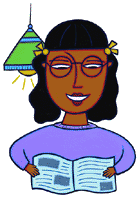

If you go by what Mark Twain says, you should never let school interfere with your education. One family makes the decision to do just that.
By Laurie O'Connell

Relaxing at our kitchen table one spring morning ten years ago, I watched my younger daughter peek out from the three-foot-deep hole she'd dug in our back yard, and wondered what she'd be doing if she were in school.
She'd be sitting up straight (or slouching) at a hard desk, paying attention (or gazing longingly out the window) while her teacher expounded on a subject in which she may (or may not) find any interest. She'd be hiding the book she was reading so that she could "learn" a rudimentary alphabet or she'd be coloring in pictures on a worksheet, following (or ignoring) the instructions not to wander outside the lines...
Worlds apart from her ruling passion at age 4: to find out what was "down there" in the earth, absorbing large doses of geology, botany and entomology — as well as dirt — in the process.
My musings were interrupted by my 6-year-old daughter's demand for more stories. With strictly literary interests, she spent her mornings consuming fairytales by the dozen, emerging from her bedroom only to grab a new armload of books.
Today, my teenage daughters are self-motivated, creative learners who are (by choice) happily integrated into the public school system. Their father and I feel that their primary education was well-spent wandering "outside the lines."
To school or not to school
Questions about the nature of learning itself spurred our family's decision to seek alternatives to public education. My husband and I were not convinced that public school, with one teacher feeding a state-defined curriculum to 30 or more children, left much room for different learning styles.
For the young child — innately curious, impulsive, enthusiastic — ongoing real-life projects such as building, gardening, cooking, art, music, and personally meaningful reading and writing seemed able to provide richer lessons in basic math, science, reading and writing than textbooks or worksheets.
My own experience with schooling added further fuel to our concerns. An early reader, I was bored and troublesome in the early primary years. The school's solution — skipping me a year — just increased my mathematical incompetence. I doubted that a homogenized "grade level" program could fulfill the needs of our children, who, like me, are verbally adroit and mathematically indifferent.
My husband and I visited the local elementary school, sitting in on several kindergarten classes. The regimented and seemingly remedial curriculum did little to dispel our doubts.
On the path to learning
We began to research alternative education. In our small town at the time, there were no suitable private schools and charter schools were still far in the future.
We then stumbled upon the work of John Holt, an award-winning elementary-school teacher who had quit the profession to spearhead the homeschooling movement. His books, How Children Fail and How Children Learn, are scathing condemnations of institutionalized education. His zeal about "teaching your own" fed our excitement about homeschooling as a viable option.
But our enthusiasm was tempered with a fair amount of worry. Two concerns were at the forefront of our minds: the friend factor and our own ability to teach.
As a first step toward addressing our concerns, we attended a local homeschooling group meeting, where we met families who related their experiences and provided lists of resources.
As it turned out, shared outings and play dates created an instant social group for our daughters. Furthermore, the homeschooled kids we met were far from isolated — most were involved in athletic clubs, music programs and community service.
A friend and educational consultant, James Glimore, M.A., helped us to put the socialization issue in perspective by noting that "whether homeschooled, public-schooled or unschooled, a child's social progress is primarily the parents' responsibility."
We also had doubts about our ability to teach a comprehensive curriculum, but the pieces seemed to come together on their own.
I had already taught the girls to read in the preschool years, and as a writer and editor, I was confident about teaching them the fundamentals of language. My husband's passion for gardening and carpentry would supply plenty of outdoor activities, and the girls already worked on the computer with him. We were fortunate in that a homeschooling neighbor, who taught math and science, welcomed our daughters to her daily program.
Outside the lines
After making connections with other homeschoolers and carefully considering our other options, we came to our decision to homeschool, oddly enough, while watching our daughters "hard at play." We were certain that their innate joy in learning could best be preserved in a flexible, stimulating and safe environment that encouraged individual exploration: our home.
If you're thinking of homeschooling, here's a primer addressing some common concerns about getting started.
> A recent immigrant from rural northern California, Laurie O'Connell is a San Francisco-based writer and editor. She can be reached at loconnell@looksmart.net.
Copyright © 2000-2025 savvyHEALTH.com. All rights reserved.
http://www.savvyHEALTH.com/
All contents copyright © 1999-2025 savvyHEALTH, Inc. All rights reserved.
This internet site provides information of a general nature and is
designed for educational purposes only. If you have any concerns about
your own health, you should always consult
with a physician or other healthcare professional. Please review the Terms of Use before using this site. Your use of the site indicates your agreement to be bound by the Terms of Use.